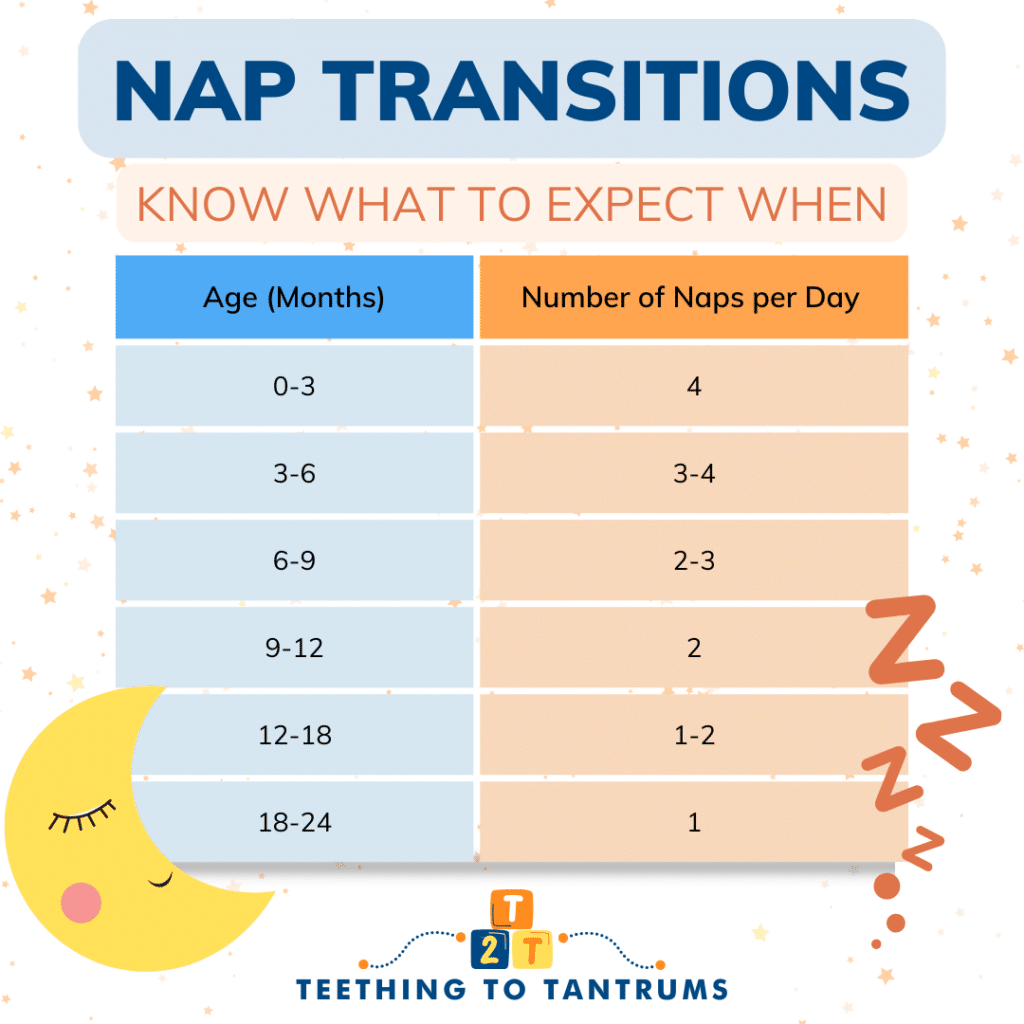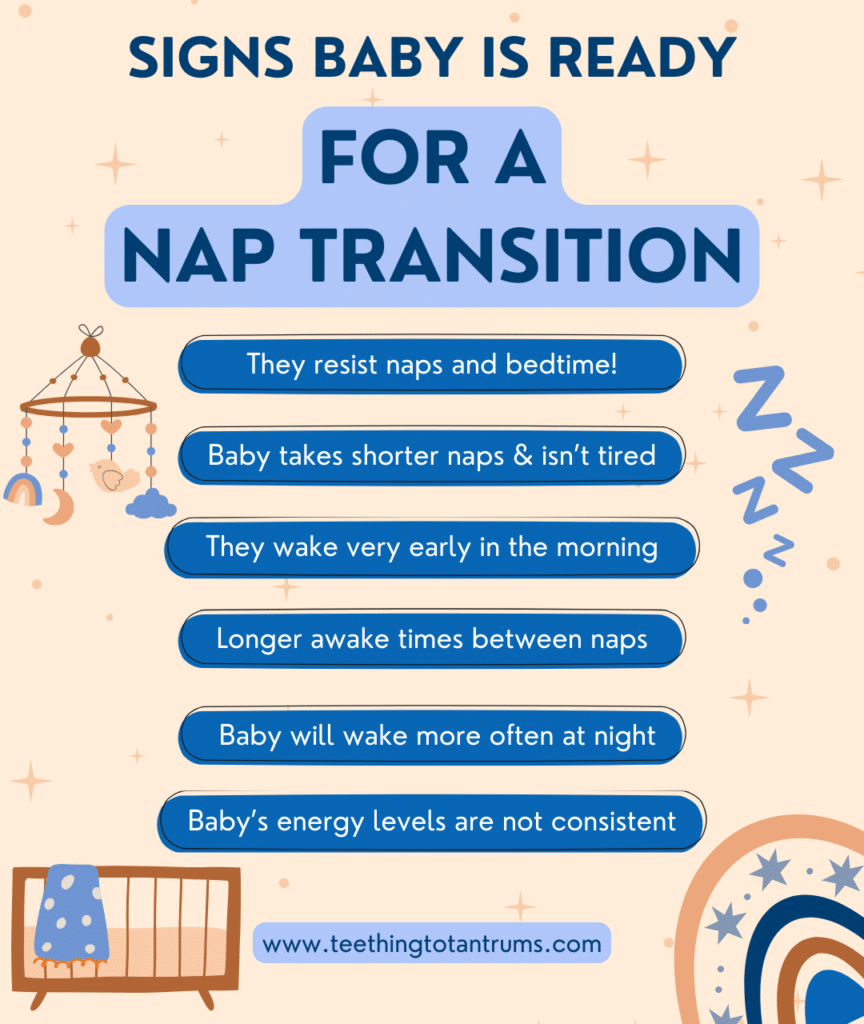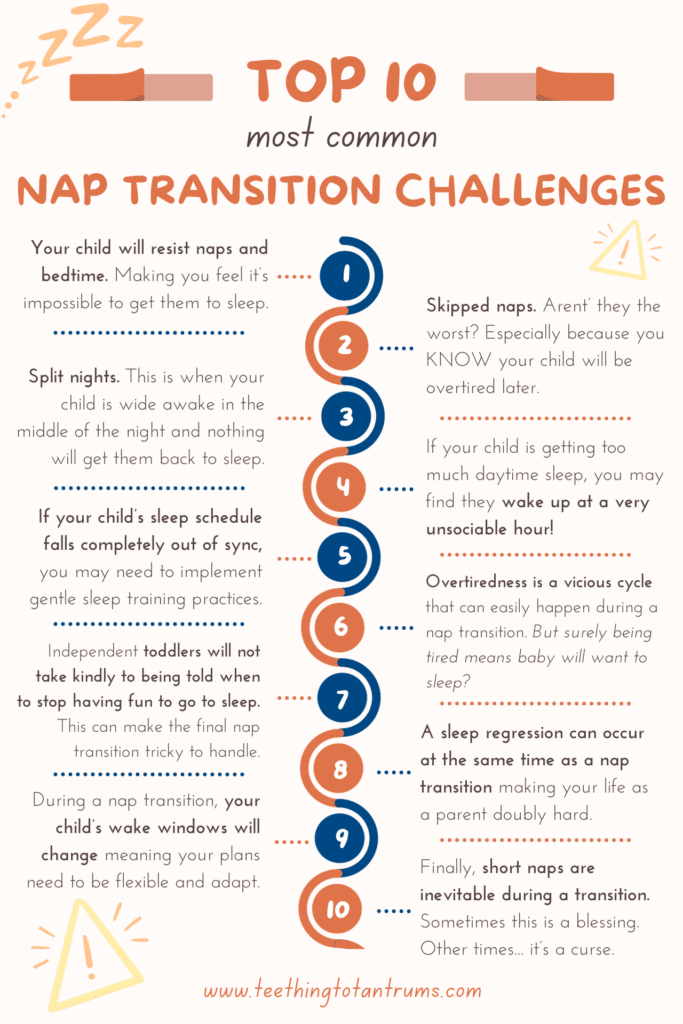As your baby grows and develops, their sleep needs change. Therefore, it’s important to adjust their nap schedule accordingly to ensure baby’s body and brain develop properly. Nap transitions are a part of this change and they can be a challenging time for both you and your little one if not managed properly.
So how do we navigate this transition with as little disruption to your little one’s sleep schedule as possible whilst ensuring both you and baby are happy, well-rested, and content?
Keep reading to find out…

Table of Contents
Key Takeaways
- Nap transitions are developmental milestones when children move from one daytime sleep schedule to another, usually around 3-4 months, 6-9 months, and 12-18 months.
- Signs of nap transitions include resisting naps, shorter naps, early waking, longer awake times, and night wakings. But each child’s timing is unique.
- To manage nap transitions: watch for sleep cues, adjust nap schedule gradually, have consistent sleep routines, move bedtime earlier, allow flexibility day-to-day, use short catnaps on busy days, and implement quiet time.
What Are Nap Transitions?
Nap transitions are developmental milestones when your baby or toddler’s sleep needs change and they move from one nap schedule to another.
These transitions usually occur around the 8-month mark, when your baby drops from three naps to two, and around the 15-month mark, when they drop from two naps to one.
However, all babies are different and it is important to follow the signs and cues your little one gives you that they are ready to drop a nap and not be guided solely by their age.
When Do Nap Transitions Happen?
As your child grows, their nap schedule will change. Here’s what you can expect as they transition from 4 naps to 1 nap per day.

When your baby is around 3-4 months old, they will typically start to transition from 4 naps to 3 naps per day. This is a gradual process that can take a few weeks to a couple of months as they start to consolidate their daytime sleep.
You will likely notice that your baby starts to stay awake for longer periods during the day and that their naps become naturally longer.
👉 To learn more about the 4 to 3 nap transition, check out my post: 4 To 3 Nap Transition: Don’t Let It Ruin Your Progress
Around 6-9 months, your baby will start to transition from 3 naps to 2 naps per day. Again, this is a gradual process that can take your baby a few weeks to a couple of months to progress through.
During this period you will probably notice that your baby is more awake and alert during the day and that their naps become longer and more predictable.
👉 To learn more about the 3 to 2 nap transition, read this post: How To Handle The 3 To 2 Nap Transition Like A Professional
By the time your baby is around 12-18 months old, they will drop down to 1 nap per day. This is a big transition and can be a bit challenging for both you and your child.
In my experience, many children of this age will take one big nap per day with shorter naps supplementing this on busy days or while traveling in the car.
A toddler’s single nap can last anywhere from 1-3 hours, depending on their age, what has been going on in their day, and individual sleep needs.
Remember to always watch for your little one sleep cues and let them sleep when they are tired. It is very easy to let a child of this age get overtired and when this happens they will fight sleep and become difficult to settle.
👉 To master the 2 to 1 nap transition, go and give this post a read: 2 To 1 Nap Transition: How To Make The Switch Successfully
Identifying The 6 Signs Of Nap Transitions
As your little one grows and develops, their sleep needs will change.
One of the biggest changes you will notice is the transition from multiple naps to fewer naps throughout the day.
This transition can be tricky to navigate, but there are signs you can look out for to help you identify when it’s time to adjust your little one’s nap schedule.
The most common signs your baby needs to drop a nap include:

- Resisting naps and or bedtime
- Shorter naps
- Early morning waking,
- Longer wake times between naps,
- More night wakings.
- Inconsistent energy levels and feeling overtired and cranky
It’s important to note that not all children will experience nap transitions at the same time.
During a nap transition, your child may become overtired, restless, and resistant to naps. This is because their sleep schedule does not fit their needs and they need a bit of help to get their sleep back on track.
It’s important to be patient and consistent with your approach during this time and to remember that it can take several weeks for your little one to adjust to the new schedule.
Looking to get your little one to sleep quickly and effortlessly? Check out my Bedtime and Nap Cheat Sheet and master the art of making daytime naps and bedtimes as seamless as possible.
A bedtime & nap cheat sheet so good your little one will ask you to put them to bed...
Laura Williams "This is a life saver! I'm so glad I downloaded your bedtime & nap cheat sheet. My little one actually asked me to put him to bed last night! Unbelievable! Thank you so much!"
Click Here For The FREE Cheat Sheet
Managing Nap Transitions
Even though transitions in nap schedules can be challenging for both you and your little one, naps are incredibly important to your baby’s health and well-being. With a little planning and patience, you can help your child adjust to the sleep changes smoothly.
Here’s how to manage the 4 biggest nap transitions.
From Four to Three Naps
Around 3-4 months, babies start to consolidate their daytime sleep, and the fourth nap becomes unnecessary.
If your baby begins resisting the fourth nap or skipping it altogether, it is time to drop it and move to a three-nap schedule.
- Monitor wake windows. Generally, when your baby is 3 to 4 months old, they have wake windows between 1.25 and 2 hours but as you transition to a 3-nap schedule, aim to increase their wake windows to 2-2.5 hours long.
- Observe sleep cues. While increasing your little one’s wake windows it is important to watch for your baby’s sleep cues. If your baby starts yawning, rubbing their eyes, or pulling at their ears… they need to sleep. Do not force your little one to stay awake. During nap transitions you will find that they need more sleep on some days than others and you should always avoid your baby becoming overtired.
- Gradually shift nap times. Gradually moving nap times by 10-15 minutes a day can help your little one to consolidate their naps.
TOP TIP: If your baby still seems to want that last nap but is stalling or fighting sleep at bedtime, use it as a brief catnap (approx 30 minutes) to help them get to bedtime without becoming overtired. You can also try bringing bedtimes forward as a tool to help your baby adjust to the new schedule and dropping the last nap of the day.
From Three to Two Naps
Between 6-9 months, babies drop their third nap and move to a two-nap schedule.
Again it is important to watch for the signs that your baby is ready for this transition. They will resist the third nap, take shorter naps, be awake for longer between naps, and wake up earlier in the morning.
To make this transition go more smoothly, do the following:
- Create a suitable sleep environment. At this age, your little one should be napping in their nighttime sleep space. Make sure the room is dark, quiet, and at a comfortable temperature. Use a white noise machine and keep the crib free of distractions.
- Have a consistent age-appropriate sleep schedule. Having a consistent age-appropriate sleep schedule will make handling a nap transition so much easier. Aim to have nap times and bedtime at the same time every day. To find the perfect sleep schedule for your baby, visit these posts.
- As always, watch for sleep cues and act on them! It is as important as ever to watch for sleep cues during nap transitions and to always let your baby sleep when they show signs of becoming tired. Not doing so will result in your baby entering an overtiredness cycle.
- Extend baby’s wake windows and move nap times. Nap transitions are a slow process so don’t try to change your baby’s sleep schedule all at once. Instead, slowly adjust naps by moving them 15-30 later each day until you reach the desired times and gradually extend your little one’s wake windows by 10-15 minutes daily. Once they can stay awake for longer periods of the day, they are ready for less daytime sleep.
- Establish a pre-nap routine. A pre-nap routine is just as important as a bedtime routine. Engage in a calming activity leading up to nap time followed by reading a book or singing a lullaby. These will become recognizable signals to your little one that sleep is coming up and will help them settle more easily.
- Bring bedtime forward. When your little one moves from 3 naps to 2, you will probably have to adjust their bedtime and bring it forward by up to 60 minutes. I would aim to have your baby in bed by 7.30 pm at the very latest when they are on a 2-nap schedule… to ensure your baby gets enough sleep to support their brain’s growth and development as well as their physical development.
TOP TIP: It is always better to let your little ones sleep when they need to and to wake them early from a nap rather than forcing them to stay awake. Your little one may still need 3 naps on some days if they’ve been very busy.
From Two to One Nap
Around 15-18 months, toddlers may be ready to drop their second nap and move to a one-nap schedule.
Signs that your toddler is ready for this transition include being able to stay awake for 4-5 hours, early morning wakings, missing the odd nap yet staying cheerful, and resisting naps daily.
Most toddlers will drop their morning nap and take one longer afternoon nap. However, every baby is different and you must watch for sleep cues to determine when your little one most needs their sleep.
When dropping to one nap per day there are things you can do to help the transition:
- Adjust bedtime. When dropping to one nap a day you will need to bring your toddler’s bedtime forward to avoid overtiredness. Check out how much age-appropriate sleep your little one needs in 24 hours to ensure they are getting enough sleep.
- Stick to a consistent sleep schedule. Having a consistent and recognizable sleep schedule that includes a pre-nap routine is essential to establishing a healthy and successful sleep routine. Find your toddler’s ideal sleep schedule here.
- Manage awake windows. Toddlers become easily overtired due to their zest for life and exploration. Keep an eye on their sleep cues and ensure that they get enough daytime sleep when they need it. Remember that a quick cat nap of 30-40 minutes can help bridge the “nap-gap” during a transition period.
- Implement quiet time. I am a big fan of quiet time and feel that it is an essential part of your little one’s routine. They are very helpful during a nap transition when your little one does not need 2 full naps a day but still needs to recharge their batteries. Having a quiet time after lunch instead of a second nap is an ideal way to help prevent your little one from getting overtired and overstimulated.
- Have a wind-down routine. Having a wind-down or pre-nap routine can help signal to your toddler that it is time to sleep and help them settle more readily. This can include a quiet activity, reading a book, saying a prayer, or singing a lullaby before putting them down.
- Take into account the impact of daycare. If your little one has started daycare or nursery, it will impact their sleep needs until they adapt to their new busy schedule. This may take the form of an extra nap or an earlier bedtime.
TOP TIP: It is important to let your daycare staff know that your toddler is going through a nap transition and ask them to adapt to your planned schedule as much as they are able.
Dropping The Final Nap
Eventually, your little one will outgrow their daytime sleep needs altogether.
The age at which this happens varies, but most children stop napping between 3-5 years old.
Signs that your child is ready to drop their final nap include waking early in the morning, resisting naps, and taking longer to fall asleep at night.
Bear in mind that as your little one transitions to not needing to nap, they may need to nap on some days and not on others.
I would always suggest that any child under 5 needs daily quiet time if they are not napping too.
When managing nap transitions, it’s important to be consistent with your approach and patient with your little one. Here are some strategies to help:
- Gradually adjust your child’s nap schedule over a couple of weeks.
- Keep an eye on your child’s wake windows and respond to sleep cues.
- Bring bedtime forward to prevent overtiredness.
- Be flexible as during a transition your little one’s sleep needs may vary from day to day.
- Don’t be afraid to wake your little one from a nap to shift their nap schedule.
- Use quiet time as a substitute for napping.
- Use the 30-minute afternoon cat nap to help your little one get through to bedtime
- Consider sleep training if your child is having trouble falling asleep or staying asleep and is getting overtired regularly.
NOTE: If you’re unsure whether your child is going through a nap transition or experiencing a sleep regression, it’s always a good idea to keep a sleep diary and consult with your pediatrician or a sleep specialist for an expert opinion.
10 Most Common Challenges In Nap Transitions
Nap transitions can be a real struggle if not managed correctly. And after years as a Norland Nanny, I’ve been through them all…
Here are the most common challenges you will face with nap transitions and some strategies I have developed to help you through them:

- Resisting naps: When babies go through a sleep change, your child may struggle to fall asleep or stay asleep during nap time. Solution: Try adjusting their nap schedule by 10 to 15 minutes a day until you reach the desired schedule. Creating a soothing nap time routine will also give your little one the right cues that sleep is coming up.
- Skipping naps: Your child may skip naps altogether, leading to an overtired and fussy baby. Solution: Ensure your child is getting enough sleep overall. Take a look at their age-appropriate sleep needs in a 24-hour period and ensure they are getting enough daytime sleep for their age. Encourage your little one to stay quietly in their crib or bed for a quiet time. Quiet times are my go-to solution for children who are skipping naps.
- Split nights: I did this a lot as a child. My poor mother! Split nights mean your baby will be wide awake in the middle of the night and there’s nothing you can do will get them to go back to sleep until they’re ready. Usually, 1-2 hours later. Solution: Increased nighttime waking may be a sign that your little one is sleeping too much during the day. Adjusting your little one’s nap schedule by cutting down on daytime sleep can help your baby sleep through the night.
- Waking early: During a nap transition, your child may wake up earlier than usual, leading to a cranky and fussy baby. Solution: Adjust your little ones day time nap schedule by 10-15 minutes and implement quiet time. Use blackout blinds to create a cozy sleep space. For toddlers, use a colored alarm clock to help them understand when it’s acceptable to leave their room.
- Sleep training: Whilst not ideal, you may need to sleep train your baby or your toddler during nap transitions if their sleep schedule is completely out of whack. Solution: Consider using a gentle sleep training method such as gradual retreat or promised return. And encourage your little one to be happy to spend time alone and awake in their sleep space.
- Overtiredness: If not managed correctly, it’s very easy for your child to become overtired during nap transitions, leading to a cranky and fussy baby. Solution: Ensure your child is getting enough overall sleep in 24 hours, always respond to sleep cues, and consider bringing bedtime forward. Implement a 30-minute cat nap on days when your little one is struggling to get to bedtime.
- Toddler stubbornness: Nap transitions can be particularly challenging for toddlers who want to show their newfound independence. Solution: Be patient and consistent with your approach and consequences. Toddlers like routine and they like to know what is coming up so stick to a recognisable sleep routine for naps to help them wind down.
- Sleep regression: Sleep regression and nap transitions often coincide which can be extra tricky to manage. Solution: Handling a sleep regression alongside a nap transition requires a consistent approach based on a stable sleep routine with naps being taken at the same time every day and bedtime being consistent. To learn more about handling sleep regressions, read this post: Sleep Regression: What, Why & Sanity Saving Solutions
- Wake windows thrown out of schedule: Your child’s wake windows will change during nap transitions and this is usually one of the sure signs they are ready to drop a nap. Solution: Adjust their nap schedule to accommodate their changing wake windows i.e. if they can stay awake for longer periods without getting over tired build their new nap schedule around this accordingly.
- Short naps: Your child may struggle to take longer naps during nap transitions. Solution: If your little one is waking early from naps, it is a sure sign that they need to drop a nap. Experiment with wake windows and aim to consolidate their daytime sleep into fewer naps.
REMEMBER: All children are different. That is why keeping an eye on sleep cues and awake windows is so important. Let your little one take the lead and guide them towards a healthy sleep schedule that suits their individual needs.
Frequently Asked Questions About Nap Transitions
Looking for more information about nap transitions? Here are the most commonly asked questions, answered just for you.
Q: What is the hardest nap transition?
A: The 3 to 2 nap transition is the most challenging for babies. It usually happens between 7 and 9 months of age. During this transition, your baby may become more irritable, have difficulty sleeping, and wake up more frequently during the night.
This video from the wonderful Dr Sarah M from Helping Babies Sleep will ensure you get through this nap transition with ease.
Q: Is there a 5 to 4 nap transition?
A: No, there is no 5 to 4 nap transition. Babies typically go from 4 naps to 3 naps around 5-6 months of age.
Q: What is the 2 3 4 nap rule?
A: The 2 3 4 nap rule is a sleep schedule that works well for babies around 6-8 months old. It involves a 2-hour wake window in the morning, a 3-hour wake window in the afternoon, and a 4-hour wake window before bedtime.
Q: How long does a nap transition last?
A: A nap transition can last anywhere from a few days to a few weeks. It depends on your baby’s age, sleep habits, and how quickly they adjust to the new schedule.
Q: At what age should a child transition to one nap?
A: Most babies transition to one nap around 12-18 months of age. However, some babies may be ready as early as 11 months, while others may not be ready until closer to 2 years old. It’s important to watch for signs of readiness, such as longer wake windows and consistent sleep patterns.
Q: What should my baby’s nap schedule look like?
A: Your baby’s nap schedule will depend on their age and individual sleep needs. A typical schedule for a 6 to 8-month-old will include 2-3 naps during the day and 11-12 hours of sleep at night. Take a look at these posts to discover what the ideal sleep and nap schedule is for your baby:
- 1-Month-Old Sleep Schedule
- 2-Month-Old Sleep Schedule
- 3-Month-Old Sleep Schedule
- 4-Month-Old Sleep Schedule
- 5-Month-Old Sleep Schedule
- 6-Month-Old Sleep Schedule
- 7-Month-Old Sleep Schedule
- 8-Month-Old Sleep Schedule
- 9-Month-Old Sleep Schedule
- 10-Month-Old Sleep Schedule
- 11-Month-Old Sleep Schedule
- 12-Month-Old Sleep Schedule
TOP TIP: Knowing how much age-appropriate sleep your little one needs in 24 hours can help when managing a nap transition. Here are the current American Academy of Pediatrics sleep recommendations.
Need More Parenting Help?
- Download our FREE Bedtime & Nap Sleep Cheat Sheet. It’s a free, easy-to-use and proven formula designed for parents of 0-5 year olds to master the art of consistently undisturbed and restful sleep without the yelling, nagging or exhausting long-winded evenings.
- Check out our Parenting Toolbox. You’ll get access to expertly-chosen products that you can guarantee are the best for your little one and your wallet.
- Are you looking for personalized guidance to navigate the challenges of parenting? I offer 1-on-1 consultations to bring you tailored strategies and actionable advice to help support your child's growth and well-being with confidence.

A bedtime & nap cheat sheet so good your little one will ask you to put them to bed...
Laura Williams "This is a life saver! I'm so glad I downloaded your bedtime & nap cheat sheet. My little one actually asked me to put him to bed last night! Unbelievable! Thank you so much!"
Click Here For The FREE Cheat Sheet


